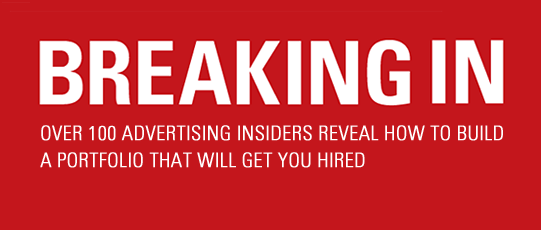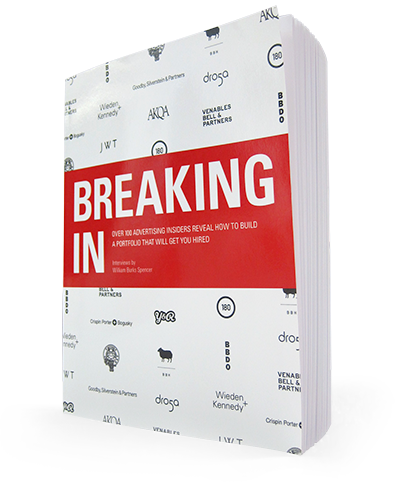Check out Jason Bagley’s work in Part 1, Part 2, and Part 3.
JB: I would say I want to be surprised and delighted. I don’t know if I should use the word “delighted.” Maybe just surprised. It’s a surprisingly rare quality in a portfolio.
WS: Surprise is surprisingly rare.
JB: Yes, surprise is surprisingly rare.
WS: Is it just breaking out of formulas?
JB: I think it takes a while to break out of formulas, and I understand…when I was first starting out in advertising, I was guilty of the same thing. But what I don’t want to see is a bunch of clever or effective solutions—communication solutions to a client’s problems.
WS: You don’t want to see that?
JB: I don’t want to see just that. And that’s what you see a lot of. It’s like, “Yeah that’s a good concept and they effectively communicated the point of what the client would have wanted.” But it’s cold and sterile and boring and unsurprising. And I think you’ve got to…for me, I want to see something where there’s personality and more of a human voice coming through so it doesn’t just feel like a corporation is communicating with me. It feels more like an actual personality is coming through. I also try to ask myself, “Is something good for an ad? Or it is just good?” Like, “Is it just great regardless of what it is? Is it just great entertainment and something that gets you excited or surprises you or just blows your mind?”
A brief is like a math problem, and the challenge is that when we come up with a solution, there’s an excitement because we have technically “solved” it. But that excitement can cloud our objectivity. Simply coming up with an answer isn’t enough—we have to come up with a beautiful, or inspiring, or funny solution that gets people to look at the problem in a new way.
I like to ask myself, “If it wasn’t mine, and I saw it in a magazine, or on TV, or online, would it inspire me, or make me laugh? Is it something I would see on TV and laugh out loud or talk to my friends about? Or is it just an ad, and do I only like it because it’s mine?” I think the vast majority of the time, it’s just an ad, and we only like things because we came up with them. So, in the very rare times I see a book that really stands out, you can tell the creator of that book has a strong voice, and they’ve broken out of that mold, of the standard, responsible, workman-like ad structure.
[ … ]
In terms of putting together a book, it took me a while to figure out what I wanted to do in advertising and the type of work I wanted to do and what my voice was. And I think it’s essential to figure that out because you see so many books—and I think most people’s first books suffer from this—but you see so many books that could have been done by anyone. There’s really nothing particularly unique about them. It can be a very good, a very solid book but there’s no personality coming through in it and there’s no voice. It’s just a standard, solid, smart portfolio.
So I think it’s helpful if someone can really kind of zero in on the type of work that they love, that they want to do. And once they know that, then hold their own work to that standard and try to put together a portfolio that represents the type of work that they are really proud of and would want to do in their career. And that can be a lot of work, but I think if you can do that, you’re more likely to be hired to do that type of work.
If your book has a clear voice and point of view to it, then there’s a greater chance you’re going to be hired to use that point of view and that voice, as opposed to just be an all-purpose creative, who can do every style of advertising, but none of it is very interesting. Many people told me when I was first in the business that the creative should be invisible in the work, but I just disagree with that—it makes for mechanical, sterile work. That doesn’t mean that you can only do comedy, or you can only do serious, epic work, but whatever you do should have a strong voice and point of view.
[ … ]
When I was trying to get into a good agency, I had a very solid portfolio that I would send around. And I was getting reasonably good responses from it. It was a very tight, solid book. But then I finally sent it to Tim Hanrahan who was working at Wieden+Kennedy at that time and he was the one who really encouraged me. He was the one who told me, “Yeah, this is a very solid book, but it’s kind of like every other book I see. I’d like to see something that represents you more.” And at that point, I stopped…I had been making a book that I thought would get me hired at an ad agency instead of making a book that I was in love with. And at that point, I threw out almost everything in my book and started over. And I stopped thinking about what any creative director, or any ad agency would think–my only criteria was: “Does this honestly represent something that I personally love and think is hilarious?” And if I couldn’t answer yes to that question, it didn’t go in. And so, with that standard in mind, I worked for I think about a year, and when I finished that, I sent it to Wieden+Kennedy, and I got a call from them within 24 hours. So I’m a big believer in figuring out what you love and trying to hold your book to that standard.
[ … ]


Comments are closed.